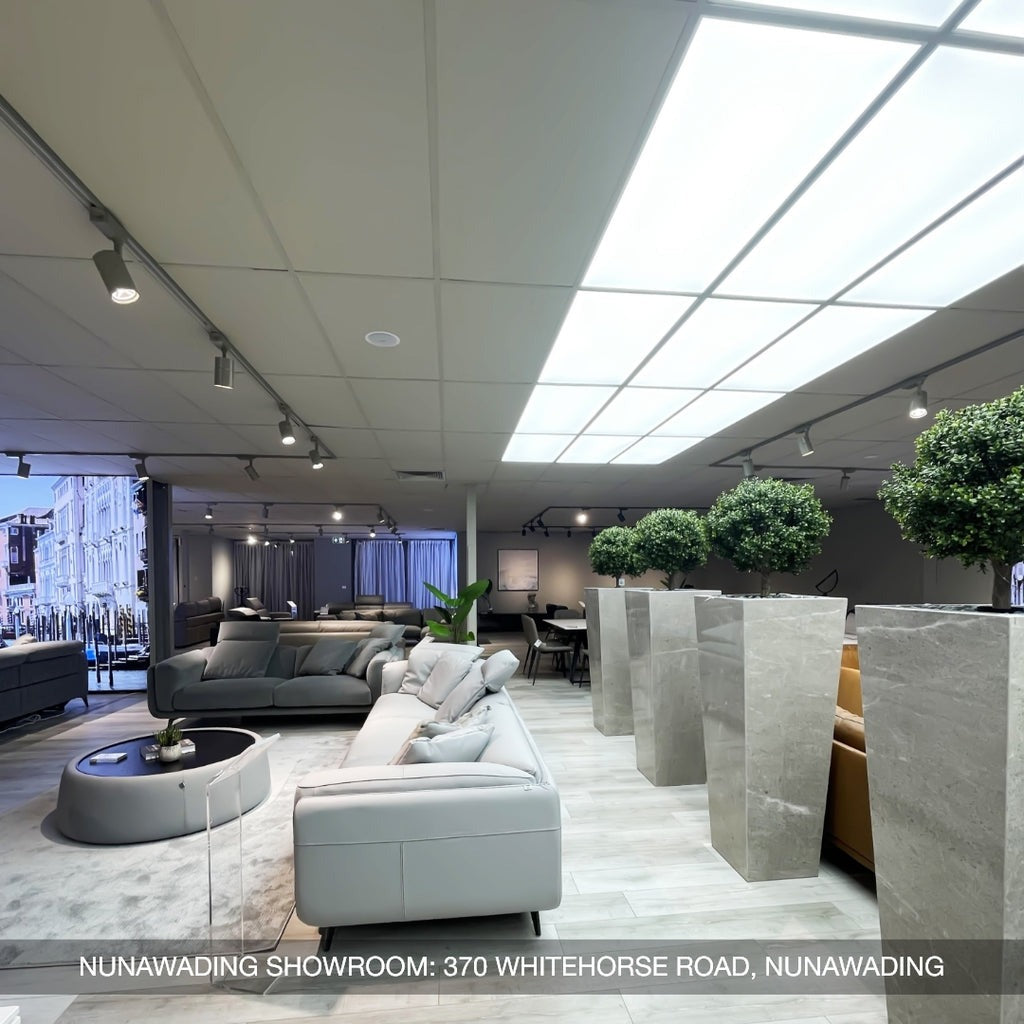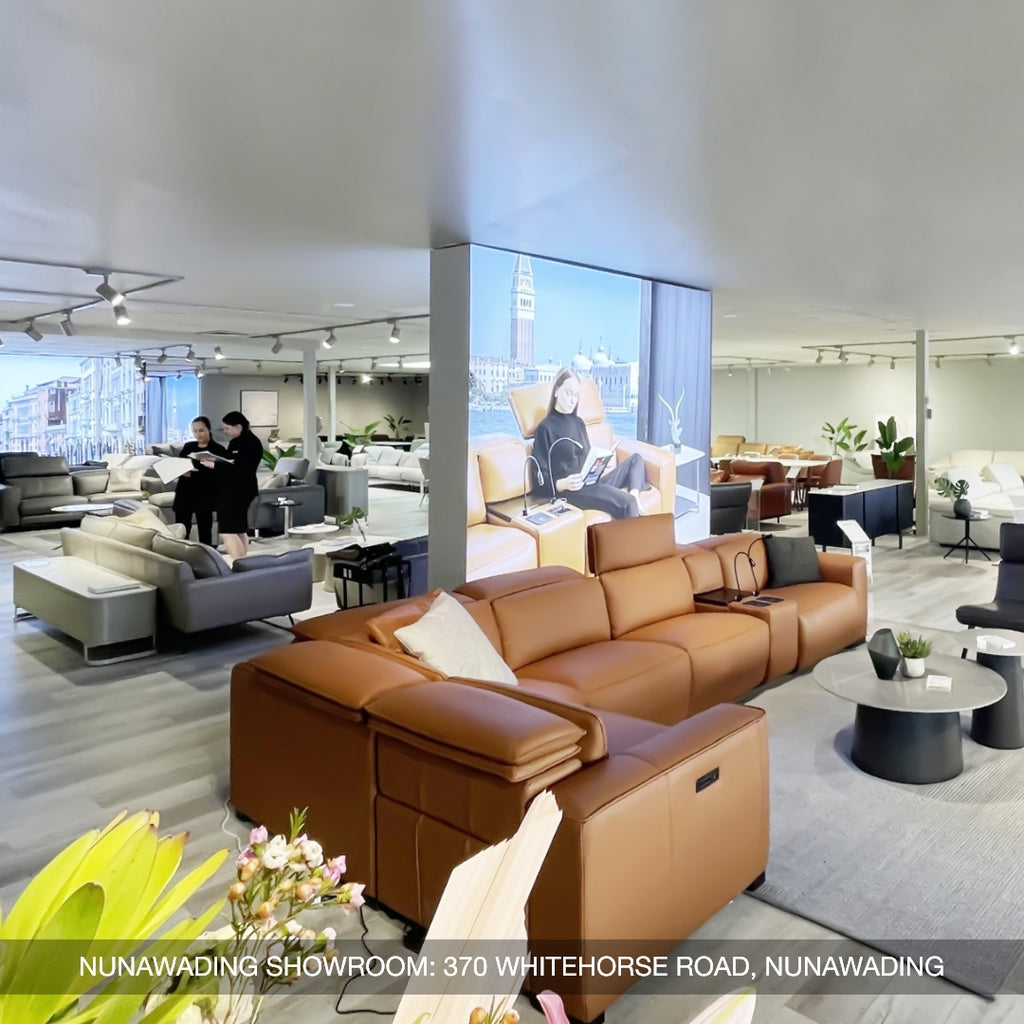The psychology of color plays a crucial role in setting the mood, whether you're looking for a calming atmosphere or a bold statement. To help guide your decision, this article will explore the trending colors for Italian leather sofas, offer insights into the ideal sofa color combination for your interior, and provide a comprehensive Italian sofa color guide. These tips will ensure your sofa choice is both stylish and harmonious with your décor.
Italian Color Psychology In Sofa Design
Italy's rich artistic heritage has always celebrated the expressive power of color. This tradition extends seamlessly into modern furniture design, where the choice of sofa color becomes a statement of both culture and personal taste.
Rosso Passione (Passionate Red)
Red has long been a symbol of passion and vitality in Italy. Its bold, vibrant nature makes it a popular choice for those who want to make a statement with their furniture.
A red Italian leather sofa draws immediate attention, becoming the centerpiece of the room. It's often paired with neutral colors to balance the intensity and add sophistication.
Red sofas pair beautifully with whites, blacks, and greys, creating a dynamic yet harmonious look.
Verde Natura (Nature Green)
Italy's stunning countryside, from its rolling vineyards to olive groves, is often reflected in green sofas. These colors bring a sense of the natural world indoors.
Different shades of green, from soft olives to deep forest tones, are part of the current color trends in Italian sofas. Each shade adds a different feel, with lighter greens evoking freshness and darker tones lending a sense of richness.
Green is often associated with calmness and balance, making it a great choice for spaces where relaxation and harmony are priorities.
Blu Mediterraneo (Mediterranean Blue)
Inspired by the blue waters of the Mediterranean Sea, this color transports the tranquility of coastal Italy right into your home.
Blue conveys reliability and peace, making it ideal for creating a soothing atmosphere.
A blue sofa, especially when paired with whites or light grays, can transform a room into a serene, elegant retreat.

Drawing inspiration from the serene waters of the Mediterranean, this shade brings the calmness of Italy’s coastal beauty into your living space.
Giallo Sole (Sun Yellow)
Yellow reflects the sunny optimism of Italy and can brighten any space. It brings warmth, energy, and cheerfulness into your living room.
While full yellow sofas are rare, this color is often used in accents or smaller pieces to invigorate the room without overwhelming it.
Yellow is known for its stimulating properties, making it a great color for social spaces where interaction is encouraged.
Grigio Elegante (Elegant Gray)
Gray is a staple of modern Italian interiors, offering a clean, sophisticated look that exudes class.
Gray's neutral nature allows it to complement a wide range of color palettes, making it an excellent option for those seeking flexibility in their décor.
Whether your style is minimalist, traditional, or eclectic, gray is the ultimate chameleon color, fitting seamlessly into any design.

Gray is a cornerstone of contemporary Italian design, delivering a sleek and refined aesthetic that radiates elegance.
Current Italian Sofa Color Trends
In the world of Italian furniture design, color trends often reflect a deep connection to Italy’s history, landscapes, and artistry. Below is a detailed look at the latest trends, blending classic Italian aesthetics with contemporary tastes.
Earth Tones
Earth tones have long been associated with the Italian countryside, particularly in regions like Tuscany where the hues of terracotta, sienna, and ochre dominate the scenery. These colors are a direct nod to the historical richness of Italian architecture and landscape, evoking warmth and grounding the space.
These earthy tones are currently part of the classic Italian color palettes, resonating with those who seek to bring a piece of Italy’s natural beauty into their homes. Earth tones also provide an excellent backdrop for a wide variety of interiors, particularly when matching Italian sofa colors with other elements like wooden furniture or warm lighting.
Jewel Tones
Jewel tones, such as sapphire blue and emerald green, have surged in popularity as homeowners seek a sense of luxury and depth in their interiors. These colors are reminiscent of the grandeur of Italian Renaissance paintings, adding richness and opulence to any living space.
Sapphire and emerald are two standout colors that offer a dramatic yet elegant touch. As seen in the italian sofa color guide, these jewel tones are especially favored by those who want to make a bold statement with their furniture. Additionally, these tones pair well with neutral or metallic accents, making them easy to integrate into a variety of color schemes.
Neutral Gradients
Neutral gradients, such as transitions from beige to taupe or light to dark gray, offer a sophisticated, subtle color scheme. While neutral tones are timeless, Italian designers have added a modern twist by focusing on smooth, gradient transitions rather than stark contrasts. This creates a calming and cohesive look.
These transitions provide flexibility in matching Italian sofa colors with other elements of interior design, such as flooring or wall paint. Gray and taupe, for instance, are versatile colors that work with almost any design, making them ideal for those who seek long-lasting style. Neutral gradients are also seen as a safe answer to the question of what color is best for sofa selections, due to their understated elegance.

These smooth gradients allow for greater flexibility when coordinating Italian sofas with other design elements, such as flooring or wall color.
Bicolor Combinations
Bicolor combinations are gaining attention as they allow homeowners to combine traditional Italian craftsmanship with a modern aesthetic. By using contrasting colors on different elements of the sofa—such as a light frame with dark cushions—designers create a striking yet balanced visual effect.
This trend allows for a creative blend of colors and textures, ensuring your sofa is a unique and personalized piece. For instance, a beige frame paired with deep blue or green cushions can evoke both a traditional and contemporary feel, making it adaptable for various color schemes.
Practical Considerations In Italian Sofa Color Selection
While the emotional aspects of color are crucial, there are also down-to-earth factors to weigh when choosing your Italian sofa's shade.
Lighting And Italian Design Philosophy
Italian design places a significant emphasis on how light interacts with color. Natural light, in particular, changes the way a color appears throughout the day. The brightness of mid-morning light might bring out the vibrancy of elegant color choices like sapphire blue or olive green, while evening light might soften these tones into more muted shades. The ability of a color to change under different lighting conditions adds depth and dynamism to the space.
Tip: To ensure you make the right choice, consider testing fabric samples under various lighting conditions in your home. This practice aligns with Italian design principles, as it allows you to assess how colors respond to the unique lighting of your room. The italian sofa color guide suggests opting for hues that maintain their appeal under both natural and artificial light, adding versatility to your design.
Spatial Harmony In Italian Interiors
A signature of Italian interior design is the seamless flow between rooms, achieved through thoughtful color coordination. By choosing colors that naturally complement adjacent spaces, you can create a sense of harmony and coherence throughout the home. For instance, if one room features terracotta accents, an earth-toned sofa can tie the spaces together.
Applying the same design logic, select a sofa color that not only enhances your living area but also complements the colors in adjoining rooms. This careful balance creates a visual connection between spaces, resulting in a unified design.
A common principle in Italian interior design is the 60-30-10 rule, which ensures balance by dividing a room’s color scheme into 60% dominant color, 30% secondary color, and 10% accent color. This approach can help you select the elegant color choices for your sofa in line with other furnishings, contributing to a harmonious and aesthetically pleasing environment.

Opt for a sofa color that not only enriches your living room but also complements the tones of neighboring spaces.
Textural Interplay
Italian craftsmanship is renowned for its use of luxurious materials, with leather and velvet being popular choices for sofas. These materials not only add physical comfort but also visual texture, which is enhanced or subdued based on color choice. Softer tones like beige or light gray tend to downplay texture, while darker shades like burgundy or emerald green can make textural elements stand out.
The psychological impact of colors can also influence how textures are perceived. Darker colors, such as deep browns or dark greens, can emphasize the richness of leather or velvet, giving the sofa a more luxurious and substantial presence in the room. Lighter shades, on the other hand, may create a softer, more relaxed feel, ideal for those seeking a calm and serene space.
Longevity And Italian Craftsmanship
Italian furniture is crafted with longevity in mind, and a well-made Italian sofa can last for decades. As a result, selecting a timeless color is essential. Unlike fast trends that come and go, classic Italian color palettes—such as earth tones, neutrals, and rich jewel tones—are enduring. These colors ensure your sofa remains stylish and relevant for years to come.
When choosing what color is best for a sofa, consider options that will age gracefully with your home. Neutral tones like beige, gray, or taupe offer versatility and adaptability as your décor evolves. Meanwhile, rich hues like navy, emerald, or burgundy add depth and elegance while maintaining a sense of timelessness. According to the Italian sofa color guide, these colors align with the long-lasting appeal of Italian craftsmanship and design principles, making Italia sofas smart investments for the future.
Choosing the right color for your Italian sofa is a balance between personal style, color psychology, and creating harmony in your home. Whether you are looking to enhance your space with bold jewel tones or timeless neutrals, our Italian sofa color guide provides the insights you need. For those looking to tailor their sofa choice to local trends, we also offer advice on color schemes for Australian interiors, ensuring a perfect fit for any setting. Visit COZY today, where our experts can help you select the ideal Italian sofa that combines elegance, comfort, and style for your home.





